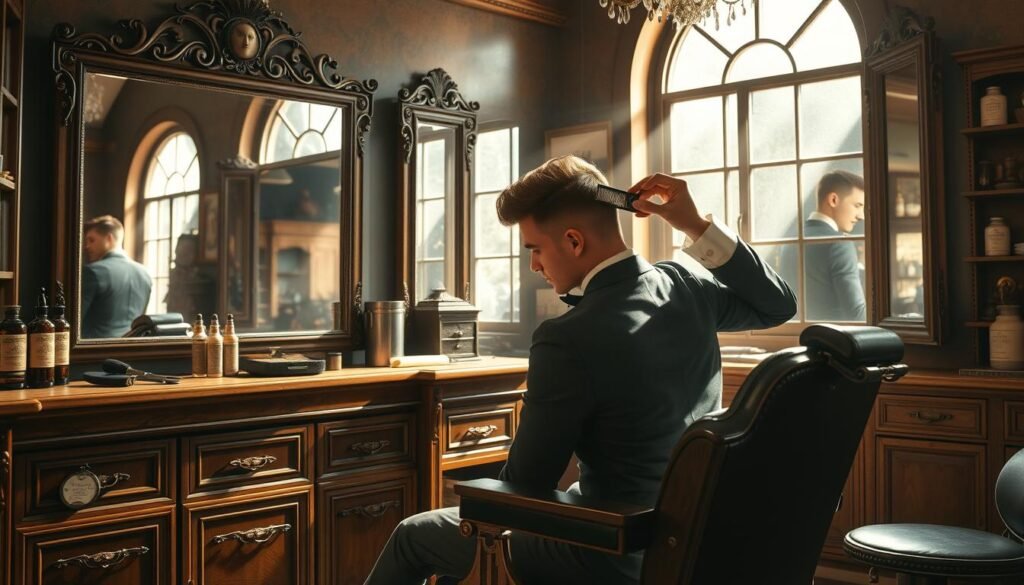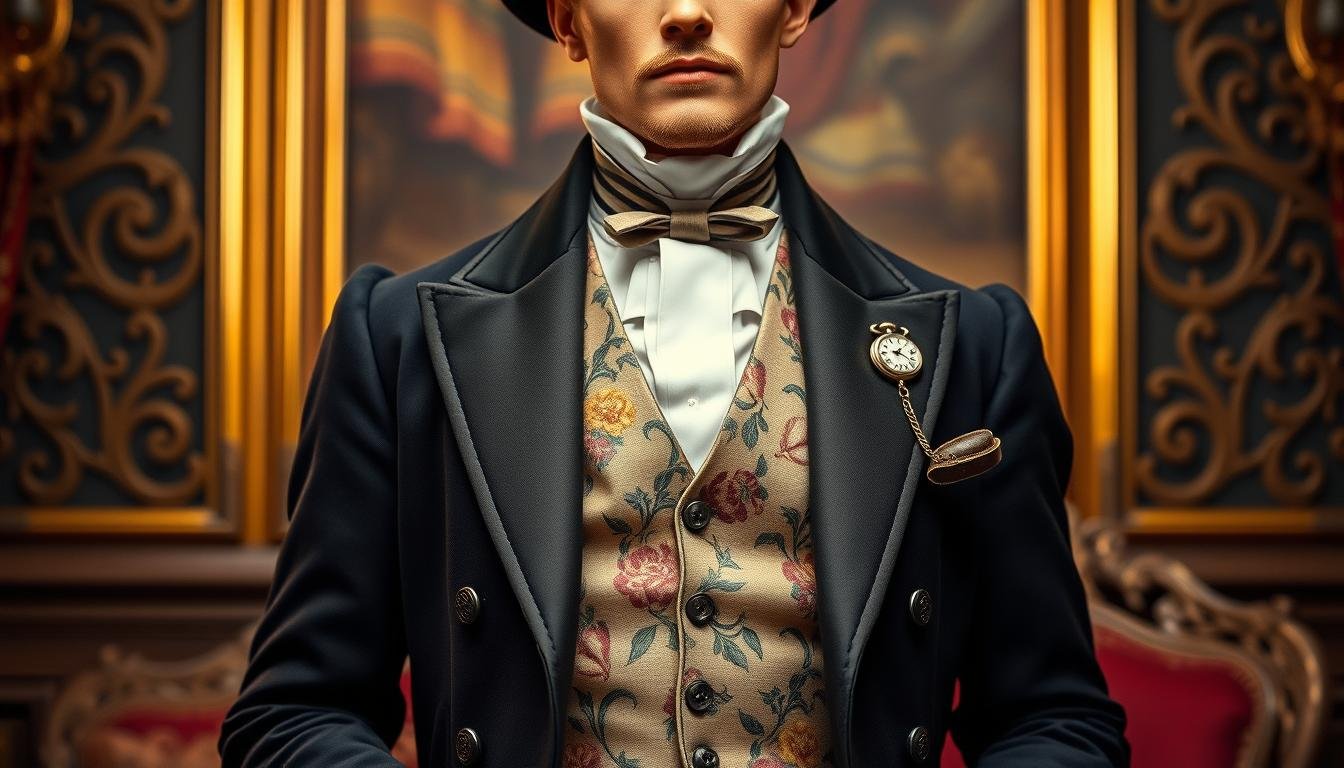The Victorian era was a time of elegant style. Men’s fashion was crucial for showing status and wealth.
Suits and accessories displayed the era’s sartorial skills. Gentlemen’s wardrobes were a testament to refined taste.
Let’s explore the key parts of Victorian men’s fashion. We’ll look at trends, clothes, and accessories from the 19th century.
These elements shaped the classic gentleman’s look. They continue to influence modern style today.
Understanding Victorian Fashion Trends
The Victorian era saw big changes in men’s fashion. It lasted from the 1830s to the 1900s.
The Victorian style evolution changed with society and new tech. Men’s fashion history shifted a lot during this time.
Early Victorian fashion moved away from relaxed Regency styles. Men wore tailored suits with high collars and waistcoats.
This formal look matched the social and political mood. The mid-Victorian era brought more variety to men’s clothes.
New fabrics like tweed and corduroy allowed for casual wear. The three-piece suit became the go-to outfit for men.
Late Victorian fashion saw even more changes. The Aesthetic movement brought flair to men’s style.
Many factors shaped Victorian style evolution. These changes showed the era’s changing views and hopes.
Learning about this helps us understand men’s fashion back then. It shows us how clothes changed over time.
Essential Victorian Garments for Men
Victorian men dressed with refined elegance. Three key pieces made up a gentleman’s wardrobe: frock coat, waistcoat, and trousers.
The frock coat had a tailored shape with a slight flare. It was suitable for both formal and casual events.
Victorian suits often included a crisp waistcoat. This added elegance and helped define the wearer’s figure.
Trousers were crucial in a Victorian man’s outfit. They were tailored and usually came in neutral colors like gray or beige.
These pants balanced the more decorative frock coats and waistcoats. Victorian fashion focused on quality craftsmanship and attention to detail.
These classic pieces still inspire fashion lovers today. Their timeless appeal continues to captivate historians and style enthusiasts alike.
Fabrics and Materials Commonly Used
Victorian Britain saw big changes in textiles. Wool suits became popular for their warmth and durability.
New dyes brought bright colors to wool clothes. Silk cravats and neckties were must-haves for fancy outfits.
The Jacquard loom made complex woven patterns possible. This new tech, plus more fiber choices, gave men many Victorian textiles options.
Accessories That Define the Victorian Look
Victorian gentlemen had essential accessories for their outfits. These items shaped the fashion sense of that time.
Victorian cravats were early versions of modern neckties. They added elegance to formal attire.
Top hats were a key part of Victorian style. Men wore them with suits for fancy events.
Pocket watches were prized by Victorian men. They showed wealth and status.
Watch chains and fobs added extra style. They made pocket watches even fancier.
Leather gloves were worn at formal events. Walking sticks were both useful and stylish.
These accessories created the Victorian gentleman’s look. This style still inspires fashion lovers today.
Footwear Styles of the Victorian Era
Men’s footwear was key in Victorian attire. It showed both style and purpose. Victorian boots were popular, with lace-up and button-up types.
These leather boots gave support and safety. They fit many events, from fancy to outdoor.
Oxford shoes were also big in Victorian times. These neat, lace-up shoes often had fancy designs.
Spats were small gaiters that covered ankles and shoe tops. They added style and kept shoes clean in bad weather.
Shoe styles changed as the era went on. Special sport shoes and mass-made footwear came about.
Victorian boot and Oxford styles still show up today. They prove how cool this era’s fashion was.
Hairstyles and Grooming in Victorian Times
Victorian men cared a lot about their hairstyles and facial hair. Their grooming showed how proper and careful they were.
Side-parted hair was a popular style for Victorian gentlemen. They often had neat sideburns to go with it.
The pompadour was another common hairstyle. It involved sweeping hair up and back from the forehead.

Facial hair was a big part of Victorian men’s look. Mustaches were very popular, with many different styles.
Beards were also common among Victorian men. Some liked full beards, while others preferred trimmed styles.
Victorian men used special products to keep their hair neat. These included pomades, oils, and waxes.
How to Incorporate Victorian Style Today
Victorian-era fashion can add elegance to your modern wardrobe. Mix in steampunk accessories like ornate pocket watches or intricate cufflinks.
Statement necklaces with industrial-chic details are another great option. These pieces blend old-world charm with contemporary flair.
Reinterpret classic Victorian silhouettes with modern fabrics and cuts. Look for tailored blazers and high-collared blouses that feel fresh.
Ankle-length skirts can pay homage to the past. Pair these with sleek denim or leather for a unique style.
Balance historical references with your personal taste. Experiment with textures, layers, and accents to create your look.
Channel the spirit of the 19th century in a modern way. Embrace Victorian elegance while staying current and stylish.
